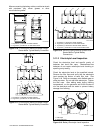TP-6200 10/12146 Section 3 Scheduled Maintenance
3.7.2 Cooling System Component
Inspection
To prevent generator set shutdown or damage caused
by overheating:
D Keep the cooling air inlets clean and unobstructed.
D Inspect the radiator’s exterior for obstructions.
Remove dirt and foreign material using a soft brush or
cloth to avoid damaging the radiator fins.
D Check the hoses and connections for leaks. Replace
any cracked, frayed, or spongy hoses.
D Check the condition and tension of the radiator fan
and water pump belt(s). Follow the belt tension
procedure in this manual and/or the engine operation
manual.
D Check the pressure cap seal and replace a cracked or
deteriorated cap. Remove dirt and other debris from
the pressure cap and filler neck. The pressure cap
raises the boiling point of the coolant, enabling higher
operating temperatures. Replace a leaking pressure
capwithoneratedforthesamepressure. The
pressure cap rating usually appears on the pressure
cap.
3.7.3 Procedure to Drain Cooling
System
For optimum protection, drain, flush, and refill the
cooling system at the intervals listed in the service
schedule.
Note: Dispose of all waste materials (oil, fuel, coolant,
filters, and gaskets) in an environmentally safe
manner.
1. Deenergize the block heater, if equipped.
2. Remove the pressure cap to allow the entire
system to drain and prevent air pockets from
restricting coolant flow through the engine block.
3. Open the radiator and/or engine block coolant drain
valve(s) and allow the system to drain.
4. If the inside of the radiator has mineral deposits or
the used coolant contains dirt or grease, refer to
Section 3.7.4, Procedure to Flush and Clean the
Cooling System. If the cooling system does not
have mineral deposits, go to Section 3.7.5,
Procedure to Refill the Cooling System.
3.7.4 Procedure to Flush and Clean
Cooling System
Use the instructions in the engine operation manual
when available to flush and clean the cooling system.
Otherwise, use the following procedure and the cooling
system cleaner manufacturer’s instructions.
1. Flush the cooling system with clean water.
2. If the inside of the radiator still has mineral deposits,
use a radiator cleaner to remove the remaining
deposits following the manufacturer’s instructions.
3. Drain, clean, and flush the coolant recovery tank.
3.7.5 Procedure to Refill Cooling
System
See the generator set spec sheet for coolant capacity.
Note: Do not add coolant to a hot engine. Adding
coolant to a hot engine can cause the cylinder
block or cylinder head to crack. Wait until the
engine has cooled.
1. Remove the pressure cap.
2. Close the radiator and/or engine block coolant
drain valve(s) and tighten the cooling system hose
clamps.
3. Open the air-bleed petcocks, if equipped. Close
the air-bleed petcocks when coolant begins to flow
from them.
4. Add coolant additives or water pump lubricants
according to the engine manufacturer’s
recommendations in the engine operation manual.
5. Fill the cooling system with the recommended
coolant/antifreeze mixture of 50% ethylene glycol
and 50% clean, softened water to inhibit
rust/corrosion and prevent freezing.
Note: A coolant solution of 50% ethylene glycol
provides freezing protection to --37°C
(--34°F) and overheating protection to
129°C (265°F). A coolant solution
containing less than 50% ethylene glycol
may not provide adequate freezing and
overheating protection. A coolant solution
containing more than 50% ethylene glycol
can cause engine or component damage.
Do not use alcohol or methanol antifreeze
or mix them with the specified coolant.
Refer to the engine operation manual for
recommendations regarding the coolant
mixture to use in extreme temperatures.


















